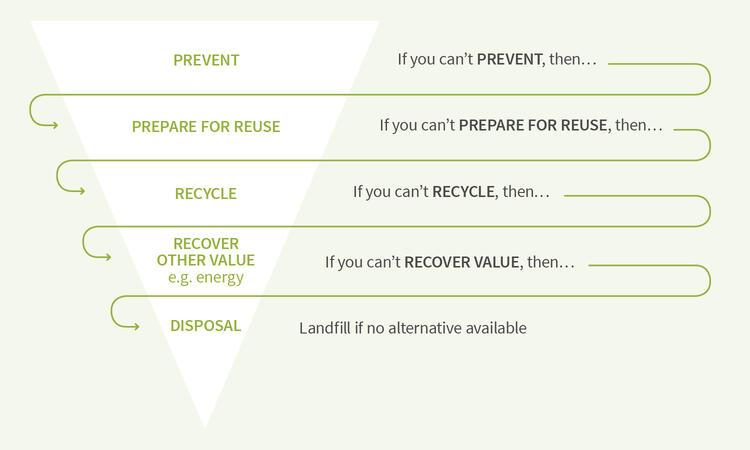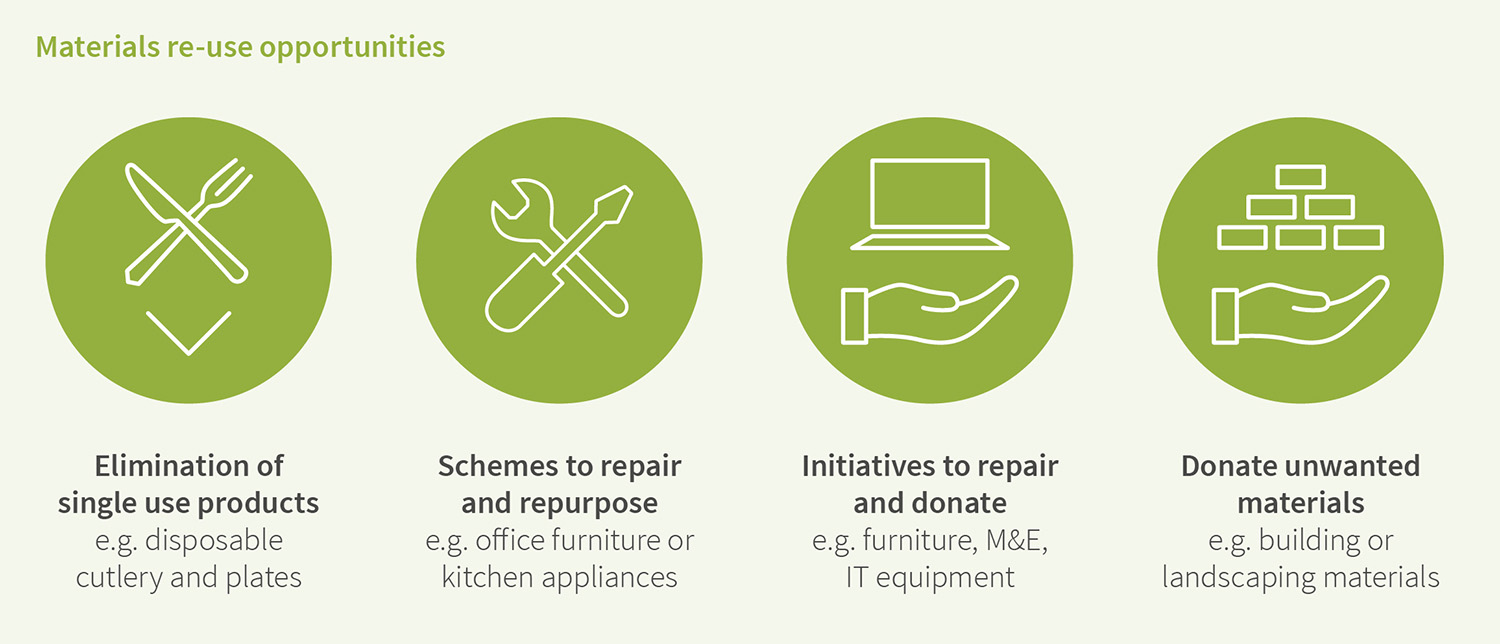GN 6.4: Waste management opportunities
Guidance Note purpose
The purpose of this Guidance Note is to provide guidance to asset managers, property managers and facilities managers in relation to options for improving waste management.
Context
The waste hierarchy concept encourages the prioritisation of different waste management options:
Prevention and reduction: using less material in design and manufacture; keeping products for longer; using less hazardous materials.
- Re-use: Checking, cleaning, repairing, re-furbishing, whole items or spare parts.
- Recycling: Turning waste into a new substance or product. Includes composting, if it meets quality protocols.
- Value recovery: Includes anaerobic digestion, incineration with energy recovery, gasification and pyrolysis which produce energy (fuels, heat and power) and materials from waste.
- Disposal: Landfill and incineration without value recovery.
The waste management hierarchy

Importance
Waste management opportunities offer a range of environmental benefit. These benefits include, for example, more efficient resource use, and fewer emissions and pollutants associated with processing and disposing of waste.
Waste management opportunities also offer a range of business benefits. These benefits include, for example, enabling legal and regulatory compliance, and a lower cost of materials and waste management services. Landfill tax in the UK is currently £94.15/tonne (as of 31 March 2021).
Poor waste management can incur considerable costs. For example, cleaning of back of house areas, fines or penalties for regulatory breaches and additional charges from contaminated waste streams.
Responsibilities & Interests
The table below summarises the key activities associated with waste management opportunities, and highlights where asset managers, property managers and facilities managers are likely to have a responsibility or specific interest.
- AM - Asset Manager
- PM - Property Manager
- FM - Facilities Manager
1. Reduce
Stakeholder:
2. Reuse
Stakeholder:
3. Recycle
Stakeholder:
4. Occupier engagement
Stakeholder:
5. On site processing of waste
Stakeholder:
6. Data and assurance
Stakeholder:
How to
Intro
Usually, waste management opportunities are co-ordinated by both property managers and facilities managers. Opportunities that require investment will be raised with asset managers for consideration.
Example of waste management opportunities have been categorised within the following clusters:
1. Reduce
Reducing the amount of waste generated on site is the most sustainable way of addressing waste, reducing waste management costs and improving site conditions, such as freeing available space otherwise used for waste storage and processing, for example.
Auditing waste streams and reviewing waste data can contribute towards a detailed understanding of a property’s waste profile. This can enable property and facilities managers, alongside occupiers, to focus on identifying opportunities to reduce waste generation.
Waste reduction opportunities are wide ranging, and could include, for example:
- Return in packaging. For example, through specification of contracts with suppliers of certain construction materials.
- Designing out waste. For example, adoption of efficient construction methods, such as ‘build-off-site’ within re-fit projects.
- Reduction in materials use. For example policies to print double sided as standard or encouraging occupiers to reduce unnecessary printing through a pay as you print scheme.
Occupiers in multi let buildings are often unaware of the amount of waste they generate. Property managers can focus attention on waste generation and reduction opportunities by creating profiles of individual occupiers’ waste streams. This can be supported by, for example:
- Undertaking waste audits of occupiers’ waste.
- Incorporating technology, such as digital scales, into waste management practices.
- Normalising waste data relating to different occupiers, creating metrics such as tons per square ft, for example, to identify comparatively large waste generators.
2. Reuse
Re-using materials waste generated on site is a preferred way to reduce waste generation and associated waste management costs.
Auditing waste streams and reviewing waste data can contribute towards a detailed understanding of a property’s waste profile. Similarly, in the context of re-fit projects, Site Waste Management Plans & pre-demolition surveys can help to identify opportunities to re-use materials.
Materials re-use opportunities are wide ranging, and could include, for example:
- Elimination of single use products. For example, replacement of disposable cutlery and plates in canteens with re-usable alternatives.
- Schemes to repair and repurpose office furniture or kitchen appliances.
- Initiatives to repair and donate office furniture, M&E or IT equipment, and external lighting and advertising equipment.
- Arrangements to donate unwanted building or landscaping materials to local charities.
Consideration should always be given to the condition of any items identified for donation and reuse. Signoff should be sought from appropriate subject matter experts and/or asset owners before items are reused, especially if given to a third party. This is especially important for IT equipment in relation to cyber security.

3. Recycle
Separating waste materials for recycling is an effective way to divert waste from landfill and incineration, and is particularly relevant for organisation operating with the built environment. Segregation involves storing recyclable material within containers for different material types, or ‘co-mingled’ into a single container.
Once collected, recyclable material will often be sent to a Materials Recycling Facility (MRF) for processing. A MRF is a specialised facility for processing large quantities of recyclable material ready for end-user manufacturing.
There are two different types of MRF:
- Clean MRFs: Accept recyclable co-mingled material that has already been separated from solid waste.
- Dirty MRFs: Accept a mixed waste stream.
Both MRF types separate designated recyclable material through a combination of manual and mechanical sorting. As a clean MRF achieves better quality recyclable material and uses less energy during processing than a dirty MRF, it is the preferred destination for a building’s recyclable material.
Segregation and the law:
UK waste management regulations in place since January 2015 require that organisations collecting paper, metal, plastic or glass for recycling take practical measures to ensure separation of these waste streams.
In Scotland the Waste (Scotland) Regulations (2016) require that organisations separate their plastic, metal, glass, paper and card or risk a fine. Businesses producing food must also recycle their food waste subject to the total amount of food waste produced. These regulations can also apply to staff canteens and food halls as well as traditional food & Beverage outlets.
4. Occupier engagement
The active engagement of occupiers when considering a property’s design and fit-out contributes towards effective waste management. Likewise, regular engagement with occupiers’ is helpful regarding planned changes in operational processes or new business activities which will result in an increase in waste material or new waste streams.
- Providing appropriate waste facilities involves understanding the waste streams which will be generated, as well as where to locate facilities so that they are convenient and most likely to be used.
- Using standardised signage and colours will ensure both cleaning staff and occupiers dispose of waste in the correct manner.
5. On site processing of waste
In some larger property contexts, there may be opportunities to process waste on-site. These opportunities may include:
- Opportunities for on-site use (composting, chipping, manufacture process).
- Onsite sorting and handling (onsite MRF) to increase recycling output and identification of further waste streams.
- Aerobic digesters technology.
When considering on-site processing of waste, it is important to receive specialist advice from a competent individual to ensure that permitting regulations are understood and adequately provided for before committing. Even small-scale operations are likely to require an exemption note from the environment regulator.
6. Data and assurance
Waste data
Identifying waste management opportunities should involve the review of reliable and accurate waste data and the outcomes from waste audits.
Waste data, especially when considered across multiple sites or across a portfolio of properties, can help to identify common waste streams, as well as anomalies in preferred waste disposal options.
Waste audits
Quality waste data can also support in the preparation of business cases for investment in waste infrastructure through the validation of waste profiles and the associated financial costs and benefits of managing these.
Waste audits can contribute towards the detailed understanding of waste streams within a property, and subsequently the identification of opportunities to better manage these.
Likewise, waste audits can evaluate the extent to which waste management arrangements are being implemented as intended, and where enhanced focus on communications and training ay be advantageous.
Related Guidance Notes
The following Guidance Notes contain related information:
- GN1.3: Environmental aspects and impacts
- GN6.2: Undertaking a waste audit
- GN6.3: Site Waste Management Plans
- GN6.5: Waste management during refurbishment and fit-out
- GN9.3 Embedding sustainability within waste management services
- GN9.5: Embedding sustainability within cleaning services
- GN10.1: The fit-out process
- GN10.2: Alterations and dilapidations
- GN11.1: Building User Guide
- GN 11.2: Engaging occupiers
- GN11.3: Service charge considerations
Additional Resources
- MAP Industry Insight on ‘Improving UK Waste Management Practices: Standardised Reporting Framework'
- MAP Industry Insight on ‘Improving UK Waste Management Practices: Procurement Specifications’
- BBP Real Estate Environmental Benchmark: 2019 Energy Snapshot
- The Waste Resource Action Programme (WRAP)
- Regulation on waste segregation for Northern Ireland The Food Waste Regulations (Northern Ireland) 2015
- Waste Hierarchy | Department of Agriculture, Environment and Rural Affairs
- Regulation on waste segregation for England and Wales
- Regulation on waste segregation for Scotland
- Landfill tax